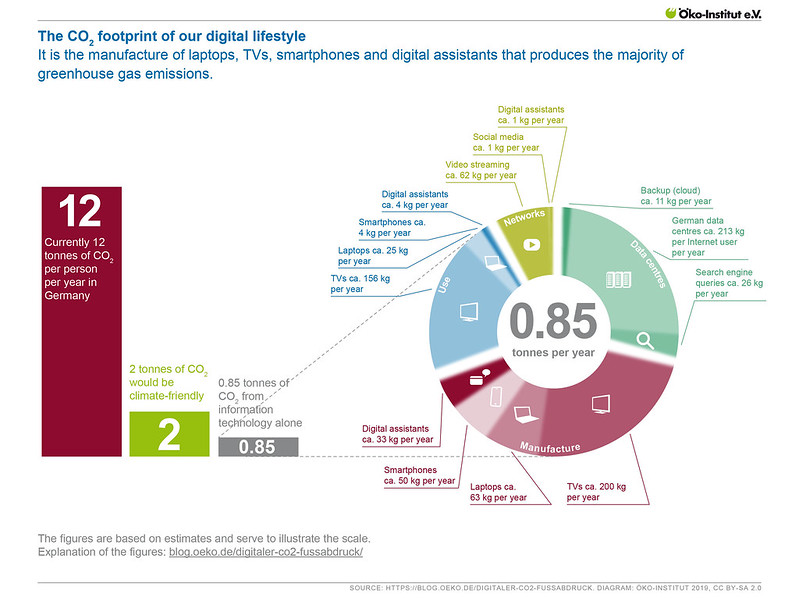The carbon footprint of our digital lifestyles

© plainpicture / Åke-Nyqvis

The CO2-Footprint of our digital lifestyle
Öko-Institut (CC BY-SA 2.0)
 Jens Gröger Quelle: Öko-Institut
Jens Gröger Quelle: Öko-Institut
How many CO2 emissions does a google query cause?
I would like to take this popular question as an opportunity to perform a few sample calculations on the carbon footprint caused by our digital lifestyle. The figures originate from our own scientific research and from external scientific sources on the production and use of information technology devices. Some of these figures are subject to great uncertainty due to rapid change in the sector resulting from technological progress and changing consumer habits. Additionally, the figures are heavily dependent on the respective framework conditions (e.g. the type of power generation). Nevertheless, I would like to make some sample calculations and use the mathematical rule of three in order to describe the magnitude of the problem. The figures have been rounded up generously in order to avoid giving a false impression of exactness.
Let’s start by setting a basis for discussion: A German citizen causes CO2-equivalent emissions (CO2e) of around twelve tons per year through energy consumption, transport and other consumption. A climate-friendly restriction would be to limit emissions to two tons per earthling.
1. Production of digital devices
The production of digital devices, such as smartphones, laptops and televisions, causes considerable greenhouse gas emissions. The emissions are caused primarily by process chemicals for raw material extraction and processing and by the energy required for semiconductor production. The manufacture of a large flat-screen TV, for instance, involves CO2 emissions of 1,000 kilograms [1]. For a laptop, 250 kilograms of CO2 are emitted during production [2]. A smartphone or a digital voice assistant (Alexa and Co.) are estimated to each emit around 100 kilograms during production. If this manufacturing effort is related to the typical useful life of a laptop, the following annual CO2 emissions result:
Greenhouse gas emissions of production based on a one-year utility period
-
Television: 200 kg CO2e per year
-
Laptop: 63 kg CO2e per year
-
Smartphone: 50 kg CO2e per year
-
Digital Voice Assistant: 33 kg CO2e per year
-
Total production: 346 kg CO2e per year
2. Use of mobile devices
All digital devices emit CO2 during their usage phase, whether at home or in the office, by consuming electrical energy. This energy consumption is highly dependent on the respective user behaviour. For the sake of my calculations, my estimations are based on assumed typical use. A television set has an output of 200 watts when being switched on and is used for four hours a day, corresponding to the average personal television consumption in Germany. The laptop is also used for four hours a day on average with an electrical power consumption of 32 watts. It is assumed that a smartphone is usually connected to the charger for four hours a day and consumes five watts during this time. The greenhouse gas emissions caused by the energy consumption during use [3] are therefore as follows:
Greenhouse gas emissions for utility period
-
Television: 156 kg CO2e per year
-
Laptop: 25 kg CO2e per year
-
Smartphone: 4 kg CO2e per year
-
Digital Voice Assistant: 4 kg CO2e per year
-
Total use: 189 kg CO2e per year
3. Data transmission
Digital devices are special in so far as that they constantly transmit data via the internet. So, unlike a toaster or an incandescent lamp, digital technology also generates an additional environmental footprint during use, which does not occur in our homes but on the internet. Yet, the cost of this energy consumption does not appear on our electricity bill. These expenses are instead covered through the basic charges for the internet service provider or streaming service provider and by the sale of data and advertising. The relationship between the level of energy consumption in data networks and the amount of data transmitted is very complex. This is to be traced back to permanent data volume fluctuation and to the design of the networks, which must consider the respective peak times with maximum data volume. Nevertheless, this relationship can be estimated as follows [4]:
Energy consumption = duration of transmission * time factor + amount of data transmitted * quantity factor
Deducting from this estimation and assuming different transmission speeds and data volumes, greenhouse gas emissions of the data network for the following activities are estimated as follows:
Greenhouse gas emissions in data networks
-
4 hours of video streaming a day: 62 kg CO2e per year
-
10 pictures for social media a day: 1 kg CO2e per year
-
2 hours of digital voice assistance a day: 2 kg CO2e per year
-
1 gigabyte backup a day: 11 kg CO2e per year
-
Total data networks: 76 kg CO2e per year
4. Data Processing Centres
In addition to the digital devices and well-developed data networks, a further prerequisite for our digital lifestyle is the existence of data centre infrastructure. Data centres can be pictured as halls filled with high-performance computers, so-called servers, as well as data storage, network technology and air conditioning technology. In Germany, the area taken up by data centres is growing annually, amounting to a total of 2.2 million square meters in 2017 [5], whilst the total electrical energy consumption in German data centres of the same year amounted to around 13 billion kilowatt hours. If this energy consumption is put in relation with the 33 million people that are estimated to be internet users by the Federal Network Agency, each internet connection would account for almost 400 kilowatt hours of electrical energy or 213 kilograms of CO2 emissions per year.
The only remaining unknown factor is the energy consumption and the associated CO2 emissions of a Google query. The data centres of Alphabet, the company behind Google, are spread all over the world, but not in Germany. One could therefore add their emissions to the emissions of German data centres. Estimations thereby suggest that a single Google query is to be compared to an equivalent of between one and ten grams of CO2 emissions. In Google’s Environmental Report of 2017, the company declared its own carbon footprint for 2016 to be a rate of 2.9 million tonnes of CO2e and its electrical energy consumption at 6.2 terawatt hours (TWh) [7]. If Google's carbon footprint is calculated in relation to another uncertain figure, the total of search queries per year (two trillion) [8], the calculations show a total emission of 1.45 grams per search query. Brief feasibility check: this would equal a total of 260 search queries per inhabitant per year. Going back to our carbon footprint: If we use the search engine by making 50 search queries per day, this causes a total CO2 emission of 26 kilograms per year.
Greenhouse emissions in data centres
-
German data centres by internet user: 213 kg CO2e per year
-
50 Google queries a day: 26 kg CO2e per year
-
Total data centres: 239 kg CO2e per year
5. Joint environmental footprint of all digital activities
By taking a closer look of the estimated CO2 emissions of our digital activities, it quickly becomes apparent that the number of Google queries is only part of the problem:
Greenhouse gas emissions of digital activities
-
Production of digital devices: 346 kg CO2e per year
-
Use of digital devices: 189 kg CO2e per year
-
Data networks: 76 kg CO2e per year
-
Data processing networks: 239 kg CO2e per year
-
Total: 850 kg CO2e per year
The manufacture and use of digital devices, the transmission of data via the internet and the use of data centres cause a total carbon footprint per person of 850 kilograms per year. This already is almost half of the CO2 budget available to us per person if climate change is to be kept within tolerable limits. If we add the further greenhouse gas emissions caused by the use of globally distributed websites, music and video streaming services, social networks, networked household appliances, video surveillance and big-data analysis and so on, the individual carbon footprint caused by information technology would easily add up to 1 ton per year or more. Hence, our digital lifestyle is not sustainable in its present form. Even if the pre-calculated figures are only a rough estimate, they still show, based on their magnitude alone, that considerable efforts still need to be made in order to reduce greenhouse gas emissions, both in terms of digital devices and in data networks and data centres. This path and no other, is the only possibility for digitisation to be made sustainable.
Jens Gröger is Senior Researcher in Oeko-Institute’s Products & Material Flows Division and an expert on sustainable consumption and products. His work focuses on information and communication technology, green procurement and eco-labelling.




